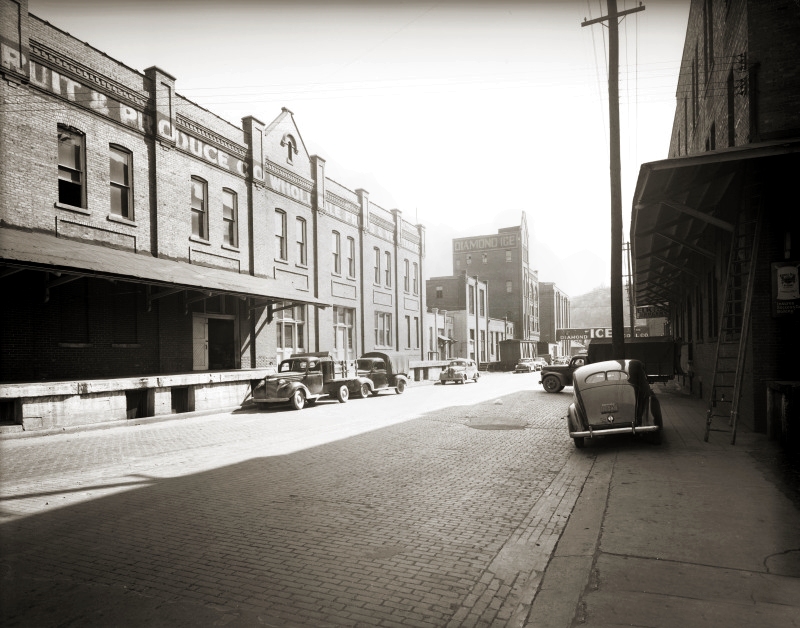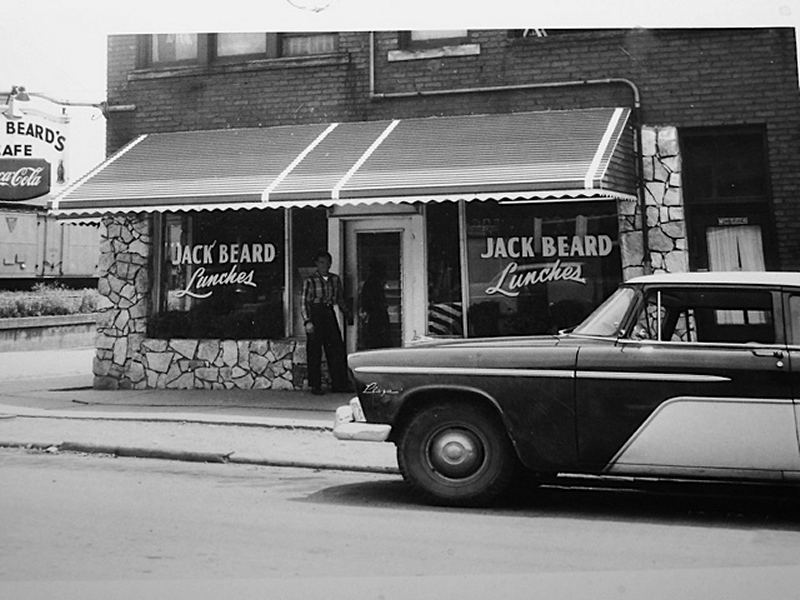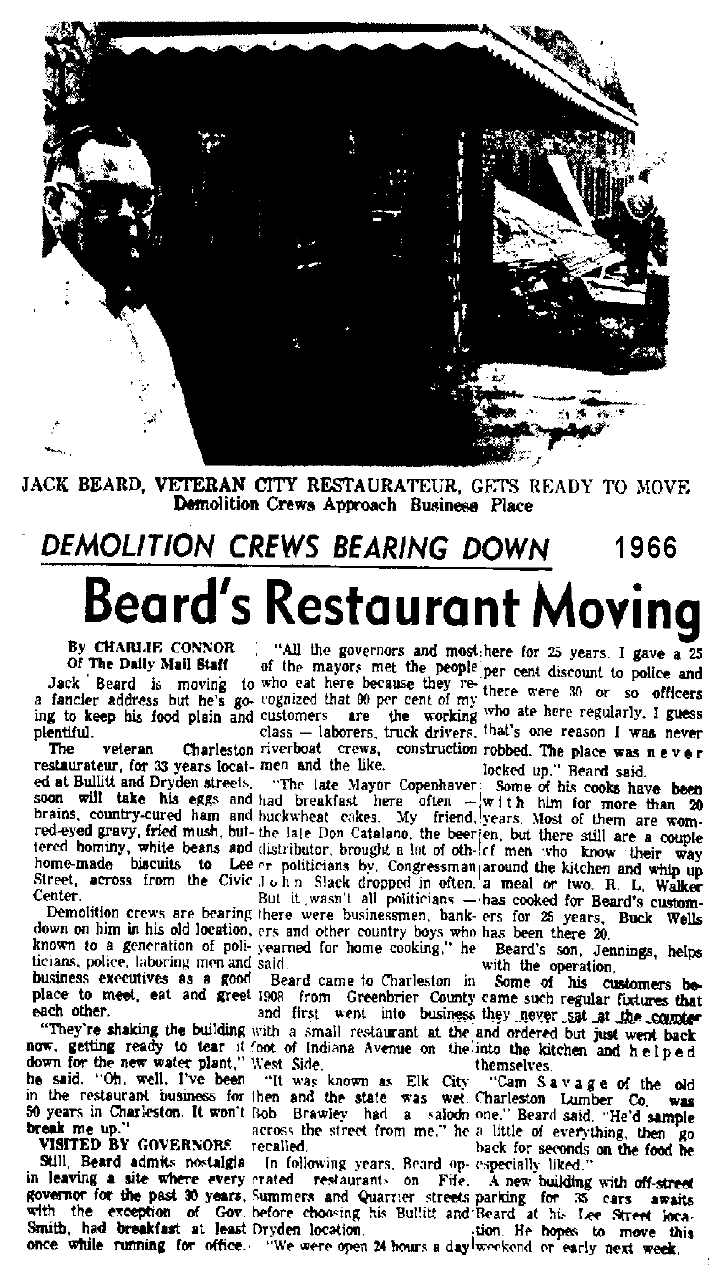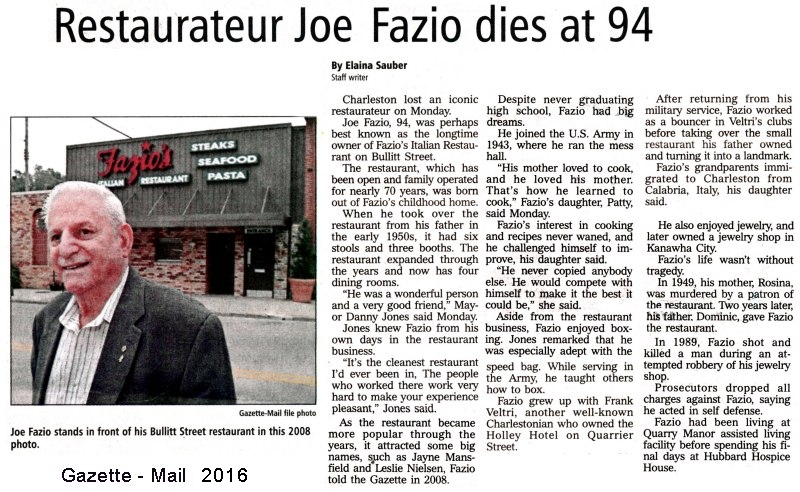Bullitt Street

This is Bullitt Street in the 50s.
Here you see the old Diamond Ice buildings on the left and right.
Also on the left is Joe Fazio's restaurant, which is still there
today and one of the most popular restaurants in Charleston.
Many celebrities have eaten at Fazio's. Where the car
is pulling out is the area my family lived in the 30s on Young and
Welch Streets. Bullitt Street crossed the railroad tracks back then
and continued toward town. Jack Beards Cafe was just on the
other side of the tracks. It too was a popular eatery in it's
day. Below is a view from the opposite direction taken in the 40s. |
 
The three Fazio brothers all served
in WWII. That's Joe, Frank, and Jimmy. I did the
graphic as a tribute.

Top Photo: This is the Fazio brothers fathers
barbershop. Their house is behind it. It's now Fazios Restaurant.

That middle child is Joe Fazio, taken around 1924 Kanawha Brewing Company

| At one time, the old Kanawha Brewing
Company stood on Bullitt Street. It was actually known by several
names. Trade Names for the brewery at Bullitt Street & the Kanawha&
Michigan R.R. were: Capital City Brewing Co 1902-1905, Charleston
Brewing Co. 1905-1906, Kanawha Brewing Co. 1907-1914. The brewery
was closed by WV State Prohibition in 1914, at which time it was converted
into a cold storage plant by the Biagi Fruit and Produce Company.
The building was later removed. There is another photo of this building
in the Panorama's section of this website. |
NOW....JUST ACROSS THE RAILROAD TRACKS...  Jack Beard's Cafe/Beer Joint on the corner of Bullitt & Dryden Streets. (where the water company is today) Jack Beard's Cafe/Beer Joint on the corner of Bullitt & Dryden Streets. (where the water company is today)
Jack Beard's Cafe was widely known for many years on Bullitt Street for their good food.
I ate many a meal there as a kid, while on my way across the old trolly bridge to Market Drive.Photo courtesy of Karen Knopp Schultz 
PFAFF & SMITH

This photo taken a block away from the
top photo, looking in the same direction. You can still see
the massive Diamond Ice building on the left. In the foreground
is the proud fleet of the famous Pfaff & Smith Company. You might
go so far as to say that most of the Kanawha Valley was built on the
backs of these concrete sand and gravel trucks. Pfaff &
Smith had a huge, and I mean huge
sand pile that I played on as a kid. Had to do it on Sunday of
course when no one was looking. The trucks were all bright
mustard yellow.
Pfaff & Smith has since sold it's
concrete, sand & gravel business. But it's history is interesting
none-the-less and calls for a trivia question: OK... READY? |
WHAT WAS THE FIRST COMMERCIALLY
PAVED STREET IN CHARLESTON?
| If you said Summers Street, you'd be
wrong. While Summers Street is considered the *first paved brick
street in America by many, it was really an experiment to see
if the system would work. Once it had proven itself, bids
were put out to pave all the streets in Charleston with brick.
Meanwhile, in 1891, Bellefontaine Ohio became the location
of the first concrete street in America. George Bartholomew
invented a process for paving using Portland cement, which until then
had been used in stone construction. A small section of Main Street,
on the west side of the Logan County Courthouse, was the first to
be paved using that process. We're only talking 9 or 10 years
from the time that first concrete street was laid and the idea of
using brick, a substance that had proven itself for thousands of years.
Concrete was still in the experimental stage when it was decided to
use brick in Charleston and many other cities. Another reason
(I'm sure) to use brick was because the Kanawha Valley had the finest
brick clay on the East Coast. This is why we normally had at
least three brick plants working at the same time. The bricks
for Charleston's streets would be made mostly by the Elk River plant.
See Here: |
SO, WHAT WAS
THE FIRST STREET COMMERCIALLY PAVED?
* Smith Street *
***************************
CHARLESTON DAILY GAZETTE, TUESDAY
JUNE 24, 1902
STREET PAVING BEGUN
CONTRACTORS PUT LARGE FORCE TO WORK YESTERDAY
Smith Street Is the First to Receive Attention and
Others will Follow Rapidly
A
large force of men was put to work yesterday on Smith street by Pfaff,
Ringwald & Smith contractors for street paving. The contractors
have made the bond necessary in all city work and advertised in
the Gazette Sunday for a large force of men and fifty teams to commence
the work on Smith street. Yesterday the breaking of ground was
inaugurated, and while they are making ready on the city thoroughfares,
the brick company on Two Mile is getting in readiness to turn out the
paving blocks by the thousands for the street improvements. The work
will continue without interruption now to the end that Charleston's
streets will be permanently improved . By the time and contracts which
have been let are finished; there will be others in progress under the
bond issue which the people will vote upon as soon as the ordinance is
passed and the election is held. The street railway company has
ordered and paid for rails for Capitol street which will be laid as the
street paving is put down. The company has within last ten days has
paid $3000 street paving tax which the city claimed, and the promoters
of the new company which has taken hold of the property propose to not
only improve the service on that one street but will follow it on other
streets in Charleston, but under the agreement entered into with the
city some time ago.
***********************
Now, I find this VERY odd, because you'd
think the city would have started with the downtown streets right?
I have a theory, and if you can discredit it, please let me know:
The downtown area, while not paved in the manner we're accustomed
to, was still pretty hard-packed gravel and tar. Once you moved
away from say... an 8 square block area, the streets were a little
less hard packed in that day. Smith Street meanwhile, was the
site of warehouses and the railroad bringing all the really heavy
stuff into town. The streets there would have been a disaster
with heavy wagons and teams of horses constantly tearing them up.
Horses and the new motorized vehicles would have had a tough time
moving freight from the Smith Street area to downtown. I have
a feeling this is why Smith Street was chosen to be the first commercially
paved street in the city. |
SO, WHO GOT THE BID TO DO THE PAVING? The answer of course was Pfaff &
Smith. However, back in that day the company's name was Pfaff,
Ringwald and Smith. They were based in Chillicothe Ohio,
but found so much work here that they decided to set-up permanent
shop. Pfaff & Smith changed hands over the years like all
companies do, but still basically stayed within a family. Hardly
anyone living in the Kanawha Valley can remember a time when the yellow
cement trucks of Pfaff & Smith weren't plodding the roads to the
next big job. And many of the riverboats and barges that plied
the Kanawha and Ohio Rivers were associated with or belonged outright
to Pfaff & Smith, who had facilities in several WV areas.
*First paved street in America.
There are many references to the "first paved street in America".
For instance, Popular Mechanics makes this claim: The first paved
road was laid down outside Detroit in 1908 at a cost of $13,534. It
was made of concrete. Until then, a surfaced road was gravel, and
often a horse was employed to pull a car out of the muddy muck.
It really depends on what kind of paving you're talking about
and even THEN you'll find arguments over who was the first.
But as stated earlier, the first experimental paving
(invented by M. Levi) was laid in 1870 by him in Charleston with Dr.
Hale applying to the city council for permission to lay it at his
own expense. This was on Summers Street, in front of Gates Paint Store,
and the paving of the block by this method was completed in 1873.
Later M. Levi obtained a patent for his invention, this was after
he improved the method by changing the way of preparing the planks
used under the bricks and sand. It seems a long time to me,
from that first experiment in 1873 to the first commercial street
brick paving on Smith Street in 1902.... |

Back to index
|









